Thinking of the CamAPS FX, aka, Batman
“With planning and preparation, I can beat anyone.”

Want to listen to the Podcast on this?
Episode 4: Mastering CamAPS FX – The Batman of AID. We take a closer look at the CamAPS FX system, which offers customisable glucose targets, continuous algorithm learning, and exceptional flexibility—ideal for people with fluctuating insulin needs, including those who are pregnant or highly active.
You can look forward to:
- The most adaptable system, allowing multiple glucose targets throughout the day, and announcement of hypo’s and high-fat meals
- Well suited for people needing tight control, such as pregnancy
- The most well-researched system across all age groups, with the most sophisticated algorithm that adapts continuously
If you select the CamAPS FX, here are the essentials:
- How the algorithm works
- Starting settings
- Tips & tricks
- Preventing and treating hypos
- High-fat meals
- Exercise
How the algorithm works
The CamAPS FX has four components:
- Dana pump of YpsoPump (with pre-filled pump cart)
- Dexcom G6 sensor or FreeStyle Libre 3 (with YpsoPump)
- An Android SMART phone. Not iPhone enabled yet (March 2025)
- The algorithm inside the CamAPS Fx APP that you connect to the sensor and pump
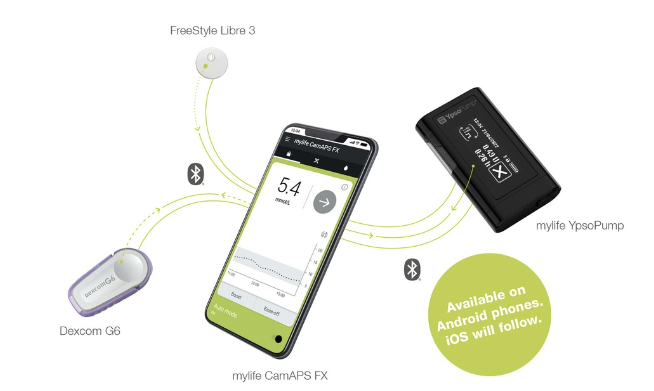
This graphic explains how the CamAPS FX algorithm works in a nutshell.
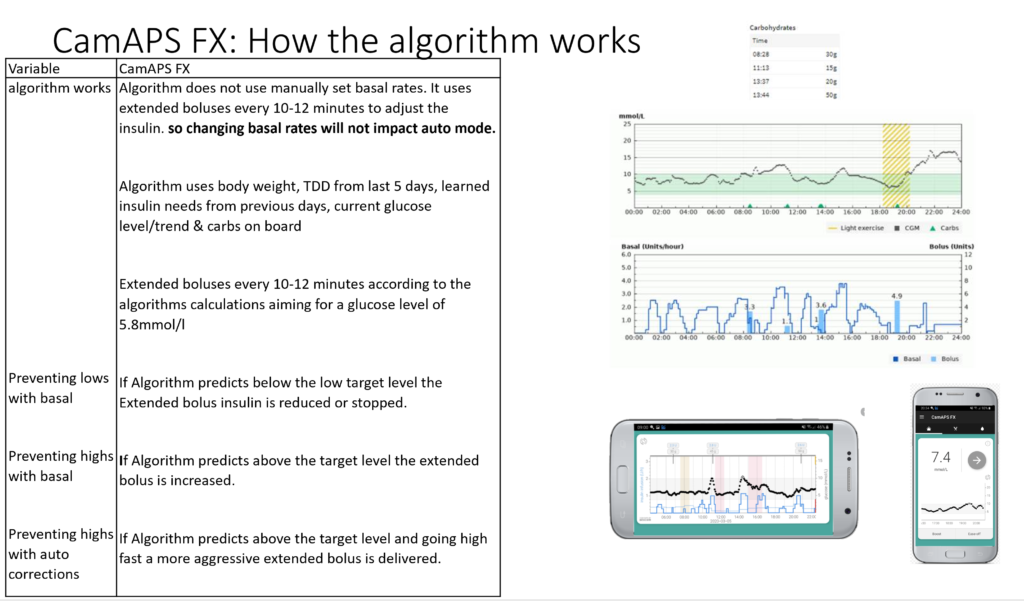
Take homes:
- The algorithm works by auto-calculating basal rates and correction factors and delivers as an extended bolus every 8-12 minutes
- Insulin increases when the glucose is rising
- Insulin decreases and suspends if the glucose is predicted to go low
- The target level is set at 5.8mmol/L (105mg/dL) which can be adjusted as low as 4.4mmol/L (80mg/dL) or as high as 11.0 (198 mg/dL) in as many time blocks as you want. This provides, ultimate flexibility.
Starting settings
The algorithms need your weight, average total daily insulin dose, and carb ratios. The algorithm does the rest. This includes active insulin time and carbs onboard time. The algorithm is continually updating and learning.
You will have to remember to keep your pump basal rates, correction factors, and carb ratios up to date in case it goes out of the algorithm.
Once the above is set, you will only need to adjust your carb ratios and target level depending on the time in range!
Starting an AID system can be divided into two parts.
First, SURVIVE,
Then, THRIVE.
You can download a How to Survive and Thrive Guide – (CamAPS Fx).
Tips & tricks
If you want to get 70% or more time in range do not forget the basics:
- Three balanced meals
- Accurate carb counting
- Bolus insulin 10-20 minutes before eating
- Be active for 10-15 minutes after eating
- Rotate cannula sites
Follow the above and you will have: 99 Problems But Highs Aint One (click if you want to download it, use it, share it!)
Other things to be aware of:
- Enter hypo treatments into the “Add meal” feature under “hypoglycaemia treatment”
- Always suspend the pump when disconnecting (showers, sports, sex)
- Keep the Android phone within 6 meters of you at all times, a waistband is a good idea
- Update pump settings for if it goes out of the algorithm:
- Basal rates
- Correction factors
- Carb ratios
- Target level
Preventing and treating hypos
It would be awesome if hypos were a thing of the past. But this will not be the case.
The algorithm will be able to stop hypos overnight!
However, if you give too much bolus insulin for a meal or exercise without planning, hypos will still happen.
You will likely need less hypo treatment than normal because the algorithm will have already slowed or stopped the insulin at least 30 minutes prior.
You may also want to prevent hypos if you see the glucose is 4.0-6.0mmol/L (70-110mg/dL) and trending down.
This is a guide I use based on weight where 30kg is used as an example. The Survive and Thrive Guide – (CamAPS Fx) allows you to enter your weight to get a personalised chart.
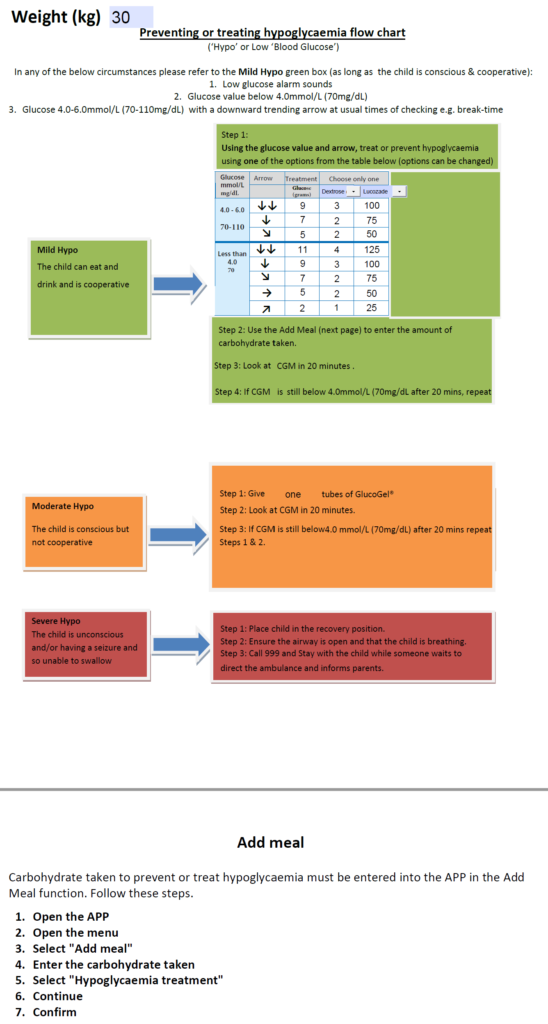
You can download the hypo chart here if you want to try it?
High-fat meals
We know from the Mealtime Insulin Guide that high-fat meals with carbs, such as pizza and takeaways require additional insulin.
The algorithm auto-calculates active insulin and carbs on board so it’s good at responding to the delayed glucose rise from high-fat meals.
However, the best results have been seen by giving 50% of the carbs upfront and adding the other 50% into the “Add meal” feature under “Slowly absorbed meal”. This lets the algorithm know that if the glucose starts to rise it should be aggressive in management.
For example, for a 100g carbohydrate Pizza, give 50g as a bolus and add 50g into the “Slowly absorbed meal” feature.
There is another option if this does not work. Give 100% of carbs upfront, then bolus for 25-50% “fake carbs” 90 minutes after eating. In this example, bolus for 100g before eating and add in 25-50g extra 90 minutes after eating.
Exercise
There is the quick and dirty way and the more comprehensive planned method.
The quick and dirty method
This involves putting on the “Ease Off” before starting, ideally 90 minutes before. Then supplement with small amounts of carbohydrates every 20 minutes as required.
Do not shovel loads of carbs in at once as the glucose might shoot high and the algorithm will increase the insulin and hypo risk.
How many carbs every 20 minutes?
Good question.
It depends on how much you weigh. Here is an example for a 50kg person. The Survive and Thrive Guide – (CamAPS Fx) allows you to enter your weight to get a personalised chart.
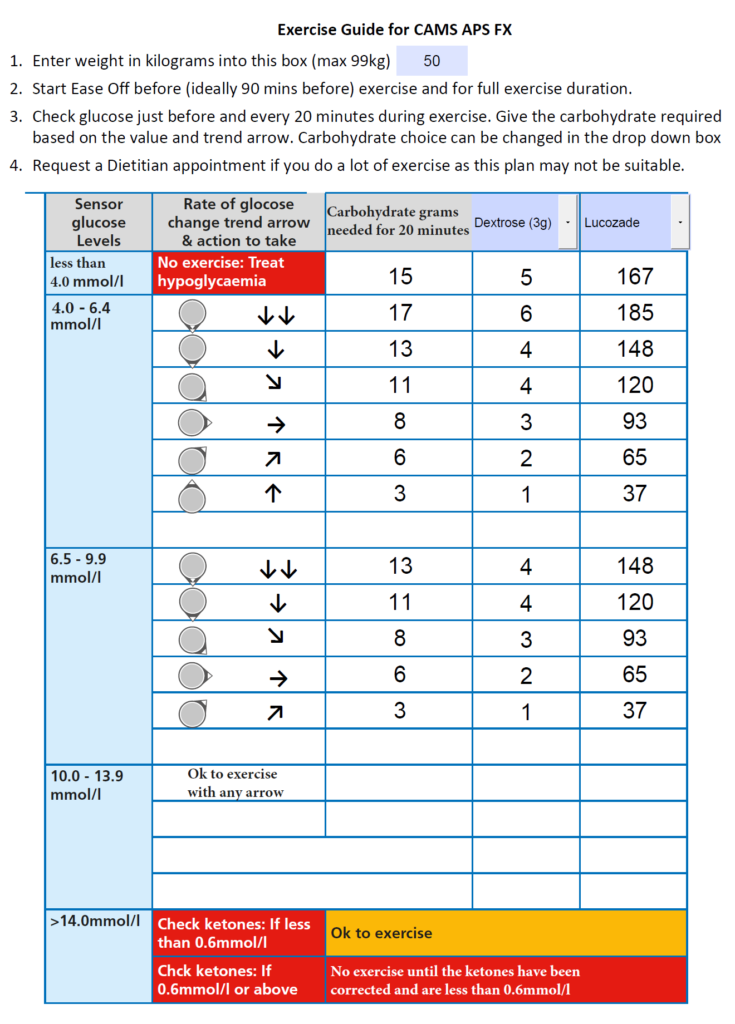
You can download the mmol/L and mg/dL versions if you want to give them a try?
Comprehensive planned method
To be able to use this method, you will need to work your way through the Exercise Guide so you understand exercise types, bolus reductions, and how to change a plan after trial.
Ready it?
Great, you are up to speed with exercise management.
This T25/T25 table should now make complete sense! If not read, the article on the recent AID and Exercise Consensus guideline, you will also notice the specific infographic below the simple T25/T25 grid.
This downloadable exercise tool for the CamAPS Fx makes creating and adapting exercise plans easy!
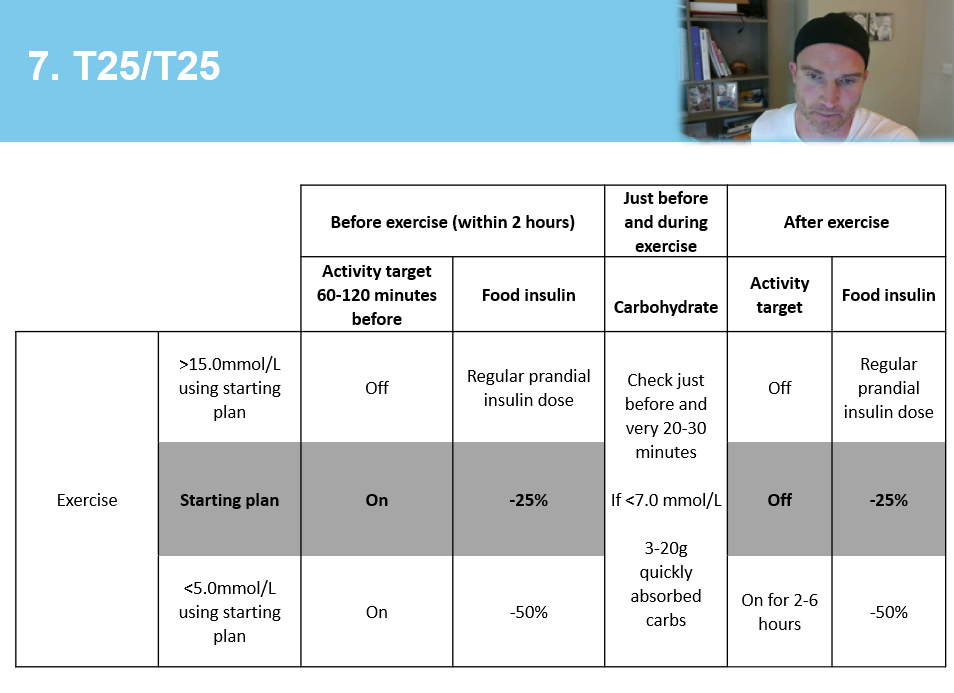

Go forth and conquer!

An excellent article. Can you go a little into hypers. Is it better to leave the system to sort it out, give a blous or use boost?. I have seen conflicting answers.
Ian
Hi Ian,
This is a great question and not a straightforward answer.
The manufacturers would say let the algorithm take care of it as then it will learn.
If you use boost it will come down faster but the algorithm will not learn.
So quick win with boost to get down vs longer game for adaptation!
Alternatively you could get moving for 15-30 mins to supercharge insulin that’s already in the system!
Sorry but no clear answer
Hi,
I want to know the comparison of medtronic 780 to Cam aps, which gives you better easier glucose control??
Hi,
I’ve recently switched the the Cam app from the Medtronic and I found Medtronic so much better! It automatically corrects highs straight away and senses low sugars so stops putting in background insulin as well – the cam aps does neither! I’ll be switching back to Medtronic.